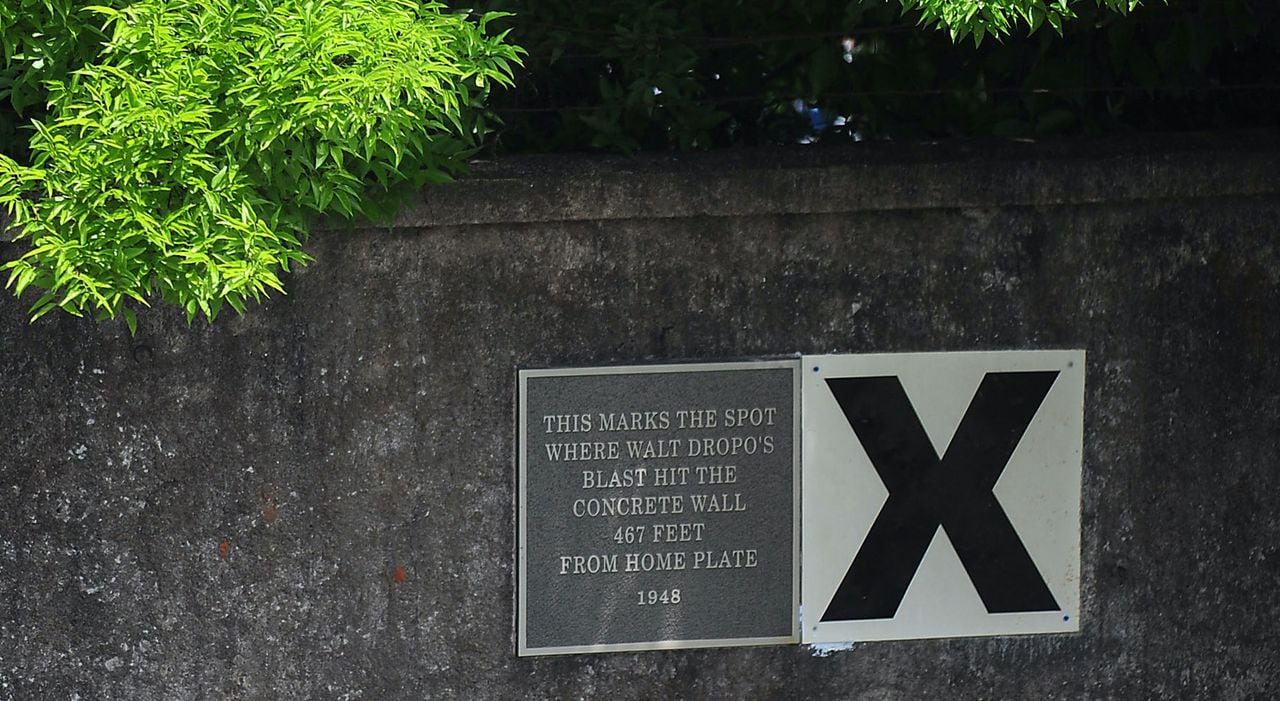Dropo, Sauer, Jackson among Rickwood’s legendary sluggers
As part of Major League Baseball’s upcoming event at Rickwood Field, AL.com and The Birmingham News will be producing weekly stories that showcase the history of Rickwood Field, and history of baseball in the state of Alabama.
“Rickwood: The legacy of America’s oldest ballpark” takes a deep dive at stories from the Negro Leagues to MLB icons playing at the historic venue, and how things are progressing as “MLB at Rickwood Field” takes place on June 20, 2024 between the San Francisco Giants and St. Louis Cardinals.
Let’s get one thing straight right off the top — Walt Dropo’s home run for the Birmingham Barons on May 21, 1948, is NOT the longest in the history of Rickwood Field. But for one reason or another, it remains arguably the most famous.
Without modern technology that tracks baseballs in flight using radar and high-speed cameras, it’s impossible to say who in fact hit the longest home run in a regulation game at Rickwood, home of the Birmingham Barons, Black Barons and other high-level baseball teams for more than 75 years until 1987. And it’s a debate complicated not only by the haze of memory, but by the ballpark’s changing dimensions.
Modeled after Pittsburgh’s Forbes Field when it was built prior to the 1910 season, Rickwood’s original outfield wall was more than 500 feet from home plate in center field and around 400 feet down the left-field line. The right field bleachers were a mere 340 feet away, and thus a far more inviting target for sluggers of the Barons, Black Barons and the various visiting teams.
At some point in the late 1940s, general manager and all-around publicity man Eddie Glennon had a new outfield wall installed in left, 60 feet closer than the original (which remained in place but was no longer in play). The 33-foot-tall manual scoreboard atop the wall in left-center was moved in as well and became a target for the heaviest hitters who played in Rickwood throughout the 20th century.
Over the years, however, Dropo’s blast — which cleared the scoreboard in left-center field and struck the outer concrete wall on the fly — has become the stuff of legend. Glennon and Bob Scranton certainly played a role in that.
Glennon, the Barons’ general manager from 1947-63, immediately told every reporter within earshot that Dropo’s home run, measured at 467 feet, was the longest he’d ever seen. Scranton, the team’s traveling secretary, had it immortalized immediately.
“The day after I hit that home run, Bob Scranton said to me, ‘Do you realize where you hit that ball and where it went?’,” Dropo told the Birmingham Post-Herald in 1989. “I said ‘Listen, Bob, I hit a home run and they said it went over the scoreboard and no one has ever hit one that far.’ Scranton said, ‘Let’s go out and see where the ball was hit.’
“Scranton, (teammate) Eddie Lyons and I went out there and he said it would have landed near the top of the wall. Scranton painted a big ‘X’ on the wall where it hit.”
An ‘X’ marks the spot on the original Rickwood Field outfield wall where a ball hit by Walt Dropo hit the wall 467 feet from home plate in 1948. (AL.com file photo by Tamika Moore)AL.com
The “Big X” remained on the concrete wall for years, before time and weather caused it to fade. It was later replaced with a more permanent metal sign commemorating the occasion.
Those who saw the home run in real time certainly were impressed. That same Post-Herald story from 1989 quoted Glynn West, who in 1948 was a teenager working the manual scoreboard at Rickwood.
“The scoreboard had these openings in it where you hung the runs scored after each inning,” West said. “I was down on about the second level. That thing had about four levels. I was looking through one of the slots.
“I didn’t have any idea it was going over. I thought it was just going to hit it. Nobody hits them over that scoreboard.
“He hit it slap over the scoreboard. That doesn’t happen. It almost cleared the back wall. It hit only a few feet from the top of the old concrete wall.”
Naylor Stone wrote in the following day’s Post-Herald that Dropo’s home run was perhaps “the longest home run ever hit in Rickwood Field.” Zipp Newman, Birmingham News sports editor from 1919-49 and the Barons’ official scorer for 44 years, said Dropo’s home run was the “talk of the town” the following day.
“Dropo’s drive cleared the scoreboard to the left of the clock and soared on against the old concrete wall,” Newman wrote. “The belt hit about 18 inches from the top of the wall, which, according to Baron Manager Eddie Glennon, measures 467 feet from home plate.
“Dropo’s ‘line drive-fly ball,’ that’s the way Manager Fred Walters describe the longest hit he had ever seen, shot over the scoreboard. The ball hit halfway up the wall — 467 feet from home plate. It would have rolled another 35 or 50 feet at the speed the ball was traveling.”
“It takes power to hit a ball nine city lots. Before the season is over Vulcan Dropo is going to hit one clear out of the park.”
The home run captured the imagination of those who saw it that it was the subject of an editorial cartoon by Jim Harden in the following day’s Birmingham News:
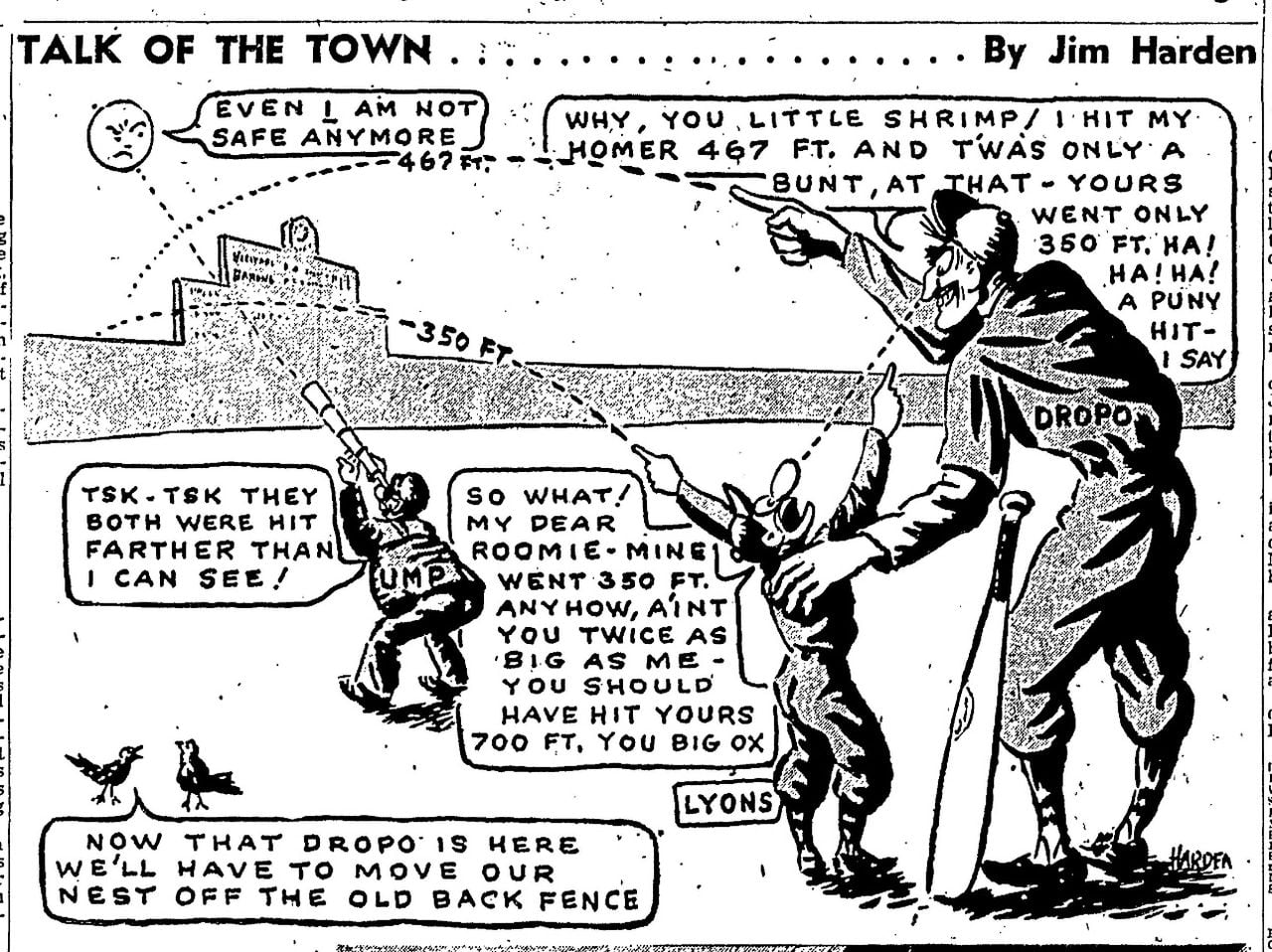
Jim Harden’s “Talk of the Town” cartoon published in the Birmingham News on May 22, 1948. (Alabama Media Group archives)bn
The home run was hit off Mobile reliever Dale Matthewson in the eighth inning of a 3-1 victory, and part of a season in which Birmingham won the Southern Association championship. The 6-foot-4 Dropo, later an All-Star and American League Rookie of the Year with the Boston Red Sox, hit .359 with 14 home runs and 102 runs batted in for Birmingham in 1948.
Baseball was then truly America’s pastime and might have exceeded even college football in popularity in Birmingham at the time. The Barons drew nearly half a million fans to Rickwood that season, and a record 14,565 on the night of Dropo’s home run.
Dropo’s home run was also personally rewarding for the big slugger. He not only got a new suit from Birmingham clothier Harold Blach (as all Barons home run hitters did in those days), also received “four steak dinners and three chicken dinners” from local restaurants and two cans of peaches from appreciative sponsors.
The home run certainly took on a life of its own as the years passed, as Dropo noted when back in town to attend the 1996 Rickwood Classic.
“It’s probably 500 feet by now,” said Dropo, who died in 2010. “A few years from now, they’ll say it landed in the center of downtown Birmingham.”
And yet, there’s pretty clear evidence it’s not the longest home run ever hit at Rickwood.
On June 18, 1941, Hank Sauer — later an All-Star with the Cincinnati Reds and National League MVP with the Chicago Cubs — became the first player to hit a home run over the scoreboard at Rickwood during a 5-3 victory over Knoxville. Observers on the scene that night argued about whether or not Sauer’s home run also went over the concrete wall.
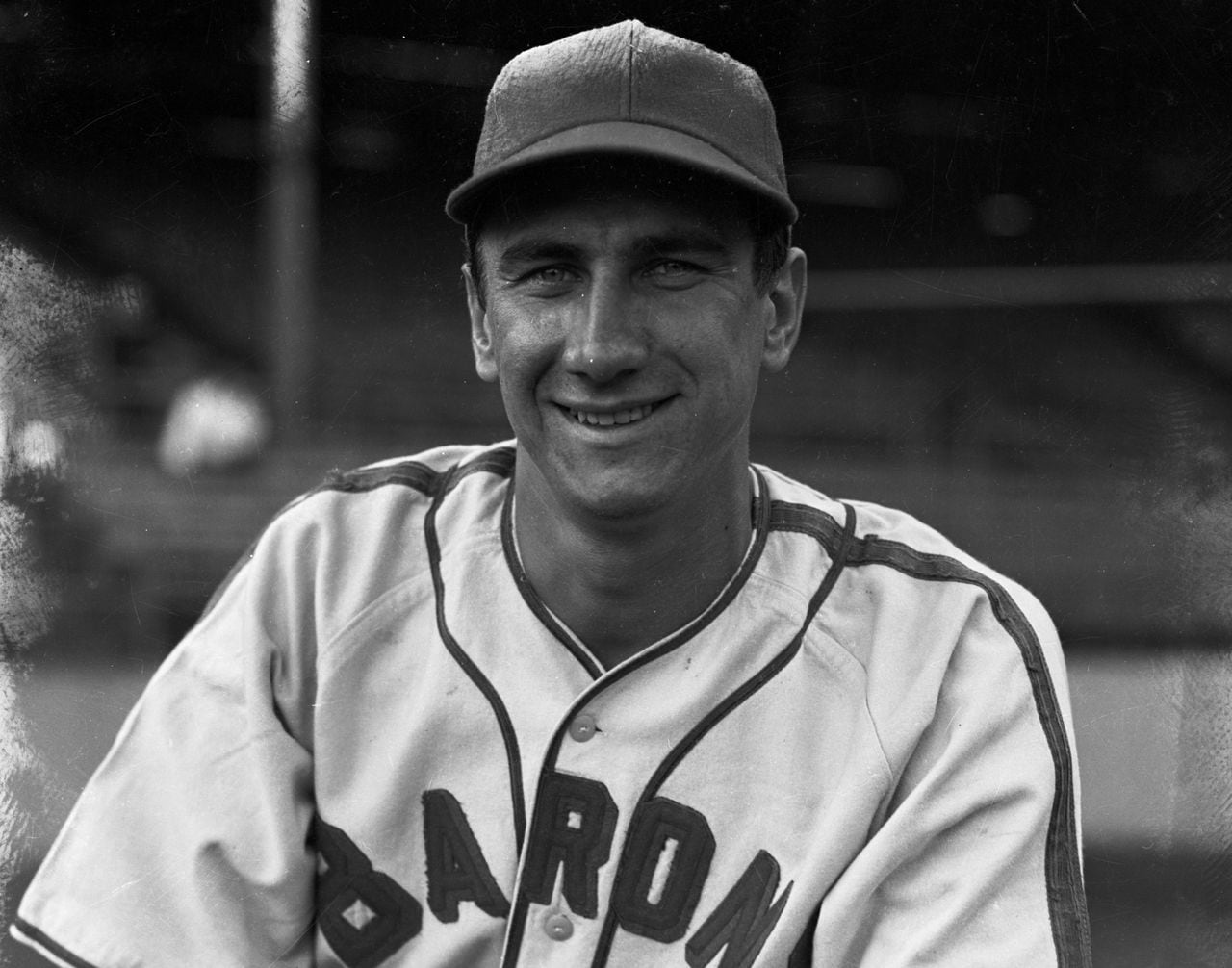
Hank Sauer, later National League Most Valuable Player with the Chicago Cubs, is shown as a Birmingham Baron in 1941. (Birmingham News file photo)Alabama Media Group
Stone wrote in the Birmingham Post-Herald that Sauer’s home run “cleared the highest part of the scoreboard” and “set some kind of a record or another.” Colleague Henry Vance wrote, “Sauer’s drive easily cleared the scoreboard and for a time it was thought it had cleared the old fence, as well.”
Sauer’s home run was said to have traveled 408 feet when it cleared the 33-foot scoreboard, though no estimated distance to its final resting place was ever put forth.
Still, Dropo’s home run seven years later immediately reminded those in attendance of Sauer’s big blast. As Newman wrote in the Birmingham News, Sauer’s was probably farther, given that the outfield wall’s dimensions had changed in the time between the two home runs.
“Hank Sauer hit his home run just to the left of the clock when the scoreboard was 65 feet farther back and 40 feet to the left of its present position,” Newman wrote. “It arched over the board. At the time it was argued the ball cleared the wall. Boys back of the board argued it didn’t. However, it seems impossible for a ball to clear the board — which was less than 10 feet from the concrete wall (and not go over the wall).”
There are a few other candidates worth mentioning.
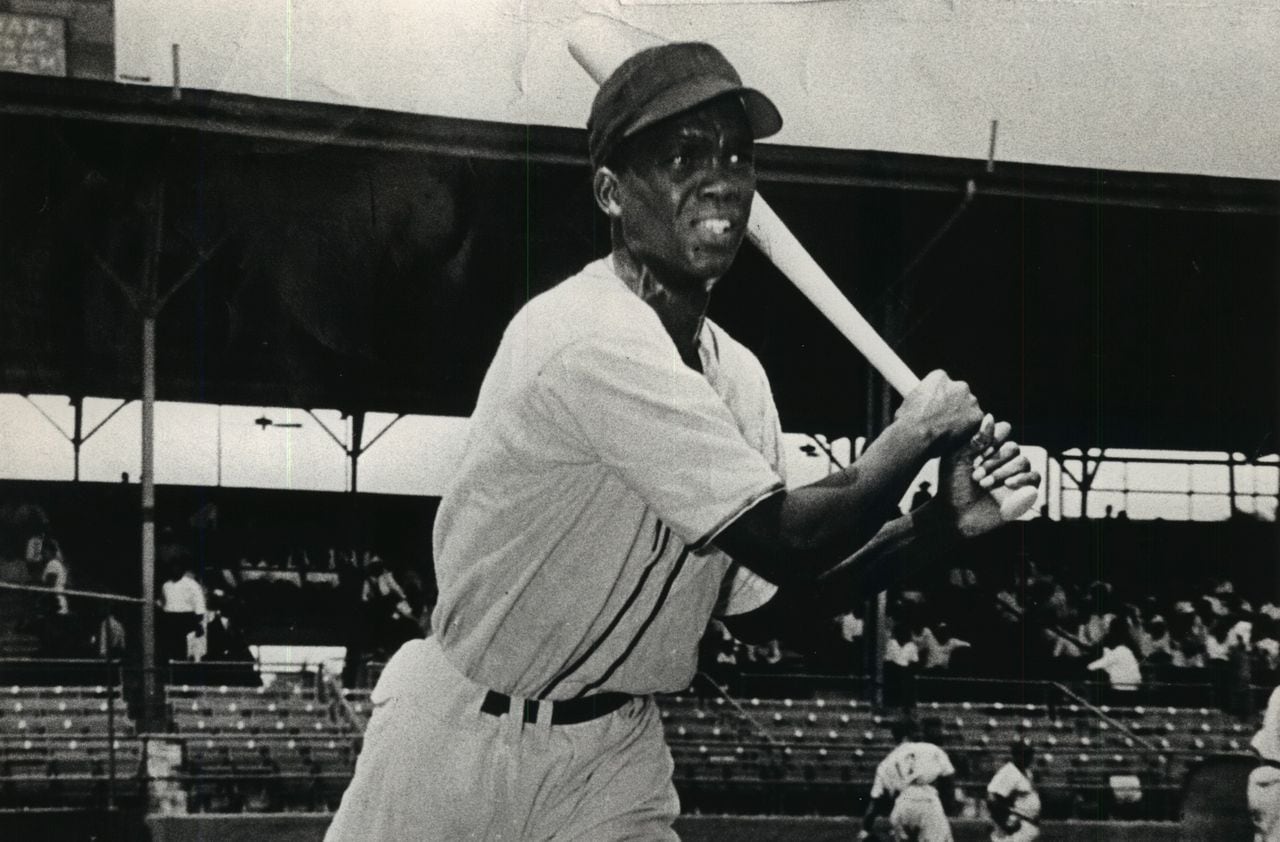
Lorenzo “Piper” Davis, Birmingham Black Barons player/manager in the 1940s. (Birmingham News file photo)Birmingham News file photo
In mid-September 1948 (the same years as Dropo’s legendary blast), Birmingham Black Barons player/manager Lorenzo “Piper” Davis, hit one in a playoff game against the Kansas City Monarchs that sailed over the far-right side of the scoreboard. Reporting on the Negro Leagues was sketchy at the time, so it’s not entirely clear how far Davis’ home run traveled, though it’s probably fair to say it was at least close to as long a shot as Dropo’s.
Two years later, Norm Zauchin (who also went on to play for the Red Sox), hit a home run at Rickwood against New Orleans measured at 472 feet. The blast “sailed over a soft drink sign atop the left field scoreboard and cleared the back concrete wall,” according to Art Black’s “Fame and Fortune in The Show: Baseball at Rickwood Field and Beyond in the Middle 1990s.”
In 1953, future major-league catcher Gus Triandos hit a 460-foot shot for the Barons over the right end of the Rickwood scoreboard. Teammate Tommy O’Brien told the Birmingham News, “Dropo hits a long ball, but he was never the hitter that Triandos is. Boy, did he powder that pitch.”
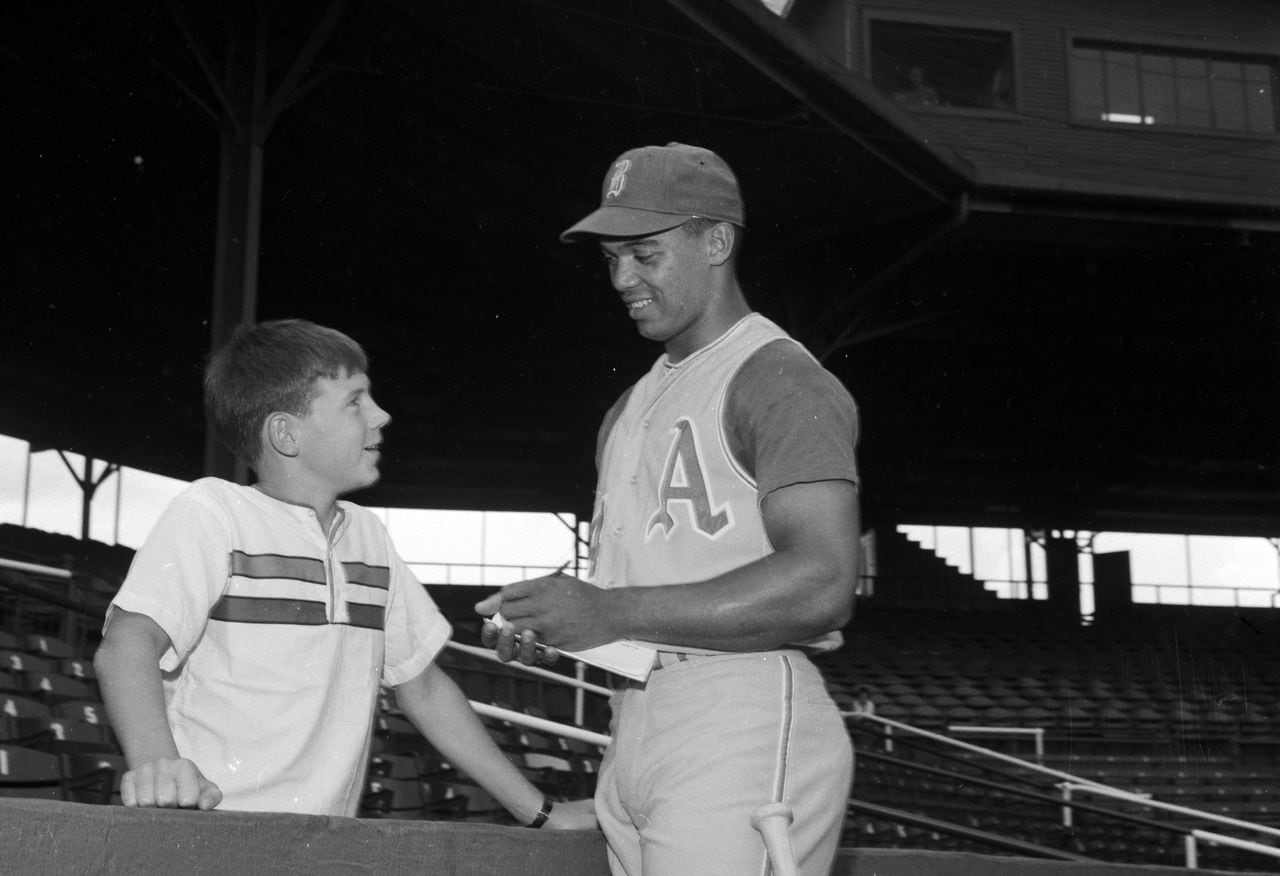
Reggie Jackson of the Birmingham A’s signs an autograph for a young fan in the stands at Rickwood Field in 1967. Jackson was Southern League MVP in his lone season playing at Birmingham. (Birmingham News file photo by Dave Battle)Alabama Media Group
Future Hall-of-Famer Reggie Jackson hit a number of memorable home runs in 1967, his lone season as a member of the Birmingham A’s. Jackson — a left-handed hitter — ripped a walk-off grand slam over the scoreboard against Knoxville on April 22 of that year, but one he hit to right field later that year was considered even more majestic.
The blast, which took place in early June, cleared the right field grandstand and was “measured to 486 feet,” as Alf Van Hoose wrote in the Birmingham News on July 16, 1967. One fan who saw the home run in-person later claimed it went “at least 550 feet.”
“I remember it going over the ‘A’ in the Arrow Collars sign,” Steve Lowery told The Birmingham News in 1996. “… It was the hardest hit ball I’ve ever seen in my life. It might not have come down yet.”
Newman wrote in the 1948 that “there is no way to settle the seething debate” as to whether Sauer’s home run went farther than Dropo’s, or vice-versa. And that seems to be the case with all the legendary long balls listed here.
Creg Stephenson has worked for AL.com since 2010 and has written about sports for a variety of publications since 1994. Contact him at [email protected] or follow him on Twitter/X at @CregStephenson.
